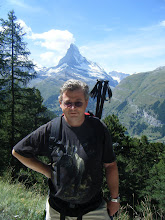The king of Europe's forests
A few months ago I wrote about Donana National Park in Spain after a visit there in September. Last week I had the privilege to visit another of Europe's great national parks, almost at the other end of the continent. I'm talking about Białowieża (byah-wo-vyeh-zhah) National Park (Białowieski Park Narodowy) in Poland.
The forest of Białowieża once extended over hundreds of square kilometres. In the 15th century, it bacame the private hunting ground of Polish monarchs, largely due to the presence of a herd of Europes' largest land mammal, the European bison (or wisent - zubr in Polish). After the partition of Poland the Tsars were the beneficiaries and some quaint 19th century lodges and other buildings still bear witness to this.
The fungus know as dead man's fingers
Joanna and Nico demonstrating the size of a fallen log...
And me showing the size of a standing tree
A Russian hunting lodge
Outside the protected area
Scots pine
Another fallen tree
The forest of Białowieża once extended over hundreds of square kilometres. In the 15th century, it bacame the private hunting ground of Polish monarchs, largely due to the presence of a herd of Europes' largest land mammal, the European bison (or wisent - zubr in Polish). After the partition of Poland the Tsars were the beneficiaries and some quaint 19th century lodges and other buildings still bear witness to this.
Sadly, the First World War changed much of that, with the occupying Germans carrying out logging on an unprecedented scale and wiping out the bison in order to feed their troops.
Intially, the new independent Poland, struggling economically, sought to maximise the short-term gain to be made from continued logging but soon came to the realisation that this was unsustainable (it had to pay compensation when it reneged on a contract to supply timber to the international market). Captive bison from zoos abroad (that had originally been given as gifts by the Government) were reintroduced to the forest in 1929 (today there are over 800 but the limited gene pool means that they remain vulnerable). It was subsequently declared a national park in 1932.
Today, the forest extends over 1,200 sqare kilometres, split more or less evenly between post World-War II Poland and Belarus. The Polish National Park has a total area of 105 square kilometres, of which 47 square kilometres is strictly protected; i.e.it can only be visited with a guide, logging is prohibited, the bison are not fed and dead wood is left to rot naturally, making a huge contribution to the variety of insects and fungi found in the forest.
As well as the bison, there are lynx, wolves, polecats, beech martens, pine martens and several other carnivores, as well as wild boar, deer, squirrels, shrews, moles and numerous other mammals. There are eight species of woodpecker, including the rare white-backed woodpecker. The dominant trees are pedunculate oak, lime, Scots pine, Norway spruce and ash, but maple, black alder, wych elm, hornbeam, mountain ash, willow, birch, aspen, yew and silver fir are also found.
It was unseasonably warm and dry when we were there on 27 December: me, Magdalena, and our friends Joanna and Nico, as well as Arek, our excellent guide. Temperatures were above zero and, against all our expectations, there was no snow. We did not see bison but we were compensated for this by seeing a the very rare great grey shrike, a small bird of prey, famous for its practice of storing prey by impaling it on thorns.
Se, what were my impressions? Well, the size of the trees, both living and dead, are what mark this forest out as special, at least in European terms. Especially in the protected part, they give it an air of cathedral-like majesty. The richness of the fungal life, even in winter, was also remarkable. In fact, although it would have been lovely to see the park in snow, we would have seen much less fungi in that event.
Now I have to go back and see it in Spring, when the ground flowers blossom.
The exposed root system of a fallen tree.The fungus know as dead man's fingers
Joanna and Nico demonstrating the size of a fallen log...
And me showing the size of a standing tree
A Russian hunting lodge
Outside the protected area
Scots pine
Another fallen tree
Dinner in a Russian style restaurant
Thanks to Magdalena for most of the photos.











2 Comments:
Hi Colman,
How is disruption, which is necessary to all forests, introduced in the park? Logging, if done sustainably, is one way. Fire is the historic method but can be a problem.
Hi. Logging is done outside the strictly protected part. Only minimal management is done inside
Post a Comment
Subscribe to Post Comments [Atom]
<< Home